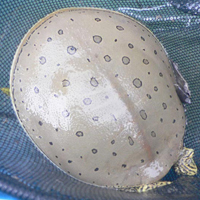Spiny softshell
Scientific name: Apalone spinifera



Cover photos credit: Allen Woodliffe
Status
Endangered
“Endangered” means the species lives in the wild in Ontario but is facing imminent extinction or extirpation.
Date added to the Species at Risk in Ontario List
The Spiny softshell was already assessed as threatened when the Endangered Species Act took effect in 2008. It was reassessed as endangered in December 2016.
Read the assessment report (PDF)
What it looks like
The Spiny softshell is a medium-large freshwater turtle that is easily recognized by its shell, which is round, rather flat, leathery and can reach up to 54 centimetres long. It is also distinguished by its snorkel-like snout.
Unlike any other Ontario turtles, this species has a soft shell. The shell is olive or tan in colour with dark blotches and tiny spine projections along the front edge. The body is usually olive, brown or grey in colour.
Where it lives
Spiny softshells are highly aquatic turtles that rarely travel far from water. They are found primarily in rivers and lakes but also in creeks and even ditches and ponds near rivers.
Key habitat requirements are open sand or gravel nesting areas, shallow muddy or sandy areas to bury in, deep pools for hibernation, areas for basking, and suitable habitat for crayfish and other food species.
These habitat features may be distributed over an extensive area, as long as the intervening habitat doesn’t prevent the turtles from traveling between them.
Where it’s been found in Ontario
In Canada, the Spiny softshell is found only in Quebec and southwestern Ontario in the Lake St. Clair, Lake Erie and western Lake Ontario watersheds. The majority of Spiny softshells in Ontario are found in the Thames and Sydenham rivers and at two sites in Lake Erie.
The size of the home range of this turtle depends on availability of habitat features such as nesting and hibernation sites. Some turtles travel up to 30 kilometres in a year from one part of their home range to another.
View a larger version of this map (PDF)
What threatens it
The most significant threat to Canadian populations of Spiny softshell is habitat degradation, particularly due to riverbank stabilization, development along shorelines, changes in water levels, dams and recreation. Nest mortality can be very high due to human recreational activities at nest sites and nest predation by raccoons and foxes. Development and recreation may also be blocking access to nesting, hibernation, feeding and basking sites. This turtle suffers high mortality due to collisions with motorboats, trapping and incidental mortality from fisheries.
Action we are taking
Endangered Species and their general habitat are automatically protected.
Recovery strategy
A recovery strategy advises the ministry on ways to ensure healthy numbers of the species return to Ontario.
Read the executive summary and the full document (December 5, 2019).
Government response statement
A government response statement outlines the actions the government intends to take or support to help recover the species.
Read the government response statement (September 8, 2020)
Habitat protection
General Habitat Protection - June 30, 2013
What you can do
Report a sighting
- Report a sighting of an endangered animal or plant to the Natural Heritage Information Centre. Photographs with specific locations or mapping coordinates are always helpful.
- The Ontario Reptile and Amphibian Atlas also collects observations of all Ontario reptiles and amphibians. Submit your observations at: www.ontarionature.org/atlas
Volunteer
Volunteer with your local nature club or provincial park to participate in surveys or stewardship work focused on species at risk.
Be a good steward
- private land owners have a very important role to play in species recovery; if you find Spiny softshell on your land, you may be eligible for stewardship programs that support the protection and recovery of species at risk and their habitats
- visit the Ontario Nature Ontario Reptile and Amphibian Atlas or the Toronto Zoo Adopt-a-Pond website to learn more about Ontario’s rare turtles, their habitat and related conservation initiatives
- because the Spiny softshell captures food by hiding in the mud of shallow waters, it is at risk of collision with boats coming in to shore; softshell turtles also often travel across the middle of lakes or bays; please proceed carefully if you know there are Spiny softshells in the area
- good nesting sites appear to be in limited supply; if you own riverfront property, maintain a buffer of open beach above the waterline; try not to disturb exposed sandbars or sand/gravel shorelines, especially during May to October
- although nests of species at risk turtles are protected, poachers will take eggs for the pet or food trade; never buy turtles that have been caught in the wild and never buy a native species of any kind that’s being sold as a pet
- as with all wildlife, don’t disturb nests, young or adults; be respectful and observe from a distance
Report illegal activity
Report any illegal activity related to plants and wildlife to
Quick facts
- the Spiny softshell turtle captures crayfish and molluscs by partially burying itself underwater in the sand or mud and snatching unsuspecting prey; its snorkel-like snout allows it to take a breath of air while submerged
- Spiny softshells hibernate underwater in sand during the winter months; they can go without breathing for the entire winter and absorb small amounts of oxygen through their mouth and cloaca (the posterior opening that serves as the common outlet for the intestinal, urinary and reproductive tracts in reptiles)
- this turtle is sometimes referred to as the “pancake” or “leatherback” turtle due to the unique appearance of its shell
